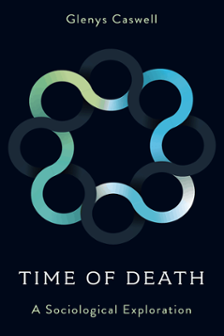
Prelims
Citation
Caswell, G. (2024), "Prelims", Time of Death, Emerald Publishing Limited, Leeds, pp. i-xv. https://doi.org/10.1108/978-1-80455-005-220241010
Publisher
:Emerald Publishing Limited
Copyright © 2024 Glenys Caswell. Published under exclusive licence by Emerald Publishing Limited
Half Title Page
Time of Death
Title Page
Time of Death: A Sociological Exploration
By
Glenys Caswell
Independent Social Researcher, UK

United Kingdom – North America – Japan – India – Malaysia – China
Copyright Page
Emerald Publishing Limited
Emerald Publishing, Floor 5, Northspring, 21-23 Wellington Street, Leeds LS1 4DL
First edition 2024
Copyright © 2024 Glenys Caswell.
Published under exclusive licence by Emerald Publishing Limited.
Reprints and permissions service
Contact: www.copyright.com
No part of this book may be reproduced, stored in a retrieval system, transmitted in any form or by any means electronic, mechanical, photocopying, recording or otherwise without either the prior written permission of the publisher or a licence permitting restricted copying issued in the UK by The Copyright Licensing Agency and in the USA by The Copyright Clearance Center. Any opinions expressed in the chapters are those of the authors. Whilst Emerald makes every effort to ensure the quality and accuracy of its content, Emerald makes no representation implied or otherwise, as to the chapters' suitability and application and disclaims any warranties, express or implied, to their use.
British Library Cataloguing in Publication Data
A catalogue record for this book is available from the British Library
ISBN: 978-1-80455-006-9 (Print)
ISBN: 978-1-80455-005-2 (Online)
ISBN: 978-1-80455-007-6 (Epub)

Dedication
To Alan for your care, support and belief during the writing of this book.
List of Abbreviations
- A&E
-
Accident & Emergency
- AMRC
-
Academy of Medical Royal Colleges
- APT
-
Anatomical Pathology Technologist
- BCE
-
Before the Common Era
- BMA
-
British Medical Association
- CCTV
-
Closed Circuit Television
- CE
-
Common Era
- ICD
-
International Classification of Diseases
- ICRC
-
International Committee of the Red Cross
- NHS
-
National Health Service (UK)
- ONS
-
Office for National Statistics (UK)
- RSPB
-
Royal Society for the Protection of Birds
- UK
-
United Kingdom (of Great Britain and Northern Ireland)
- UN
-
United Nations
- WHO
-
World Health Organization
About the Author
Glenys Caswell is an independent death studies scholar and University of Nottingham associate. She is a sociologist by training and her area of research interest focuses on the social management of dying and death. She has researched and published on aspects of dying alone, time of death and Scottish funerals. This is her second book, the first being called Dying Alone: Challenging Assumptions, which was published in 2022.
Preface
In 2017, I gave a paper at the 13th International Conference on the Social Context of Death, Dying and Bereavement, which took place at the University of Central Lancashire, in Preston in the north of England. The paper focused on the ways in which dying alone was represented in the media, and one person attending suggested that time would make an interesting lens through which to look at experiences and representations of dying alone. This seemed so obvious that I wondered how I could not have thought of it myself. It also prompted me to think about death and dying more broadly in terms of time. It also led me to think about the time when my mother died and to realise that although I knew she died in May 1999, I could not remember the date nor the time of day. And I also realised that it didn't matter. I remembered, instead, the overall experience which was one of a gathering of family. I searched the academic literature for research and thinking about time in relation to death. I found swathes of work on time, including in the social sciences, but not so much about time in relation to death. As someone who enjoys detective stories for the narrative tendency to tie up all the loose ends and restore order to a chaotic world, I began to look into how true to life fictional pathologists are when they state confidently when someone died. By following up on the ideas, theories and stories about time that I found, I fell down the proverbial rabbit hole and, realising that I had no idea what time actually is, I felt compelled to do some explorations of my own. This is the first outcome of that work.
Acknowledgements
There are a number of people and organisations to whom I owe thanks, as I would not have been able to write this book without their different contributions. First, I would like to thank the British Academy and the Leverhulme Trust for funding the research on which the book relies in constructing its argument. I would also like to say thank you to Katy Mathers and the team at Emerald for their supportive approach while I was writing the book. Most important of all, I want to say a sincere thank you to Home Office registered forensic pathologist, Dr Stuart Hamilton, and to all the people who took part in my research. I appreciate your generosity in sharing your knowledge, time and experiences with me, and I can truly say that without you there would have been no book. So thank you.
- Prelims
- Chapter 1 Introduction
- Chapter 2 A Brief Look at Time
- Chapter 3 Considering Death
- Chapter 4 Time and Death
- Chapter 5 Measuring Time of Death
- Chapter 6 Bereaved People's Experiences of the Time of Death
- Chapter 7 The Social Construction of the Time of Death
- Chapter 8 Conclusion
- References
- Index